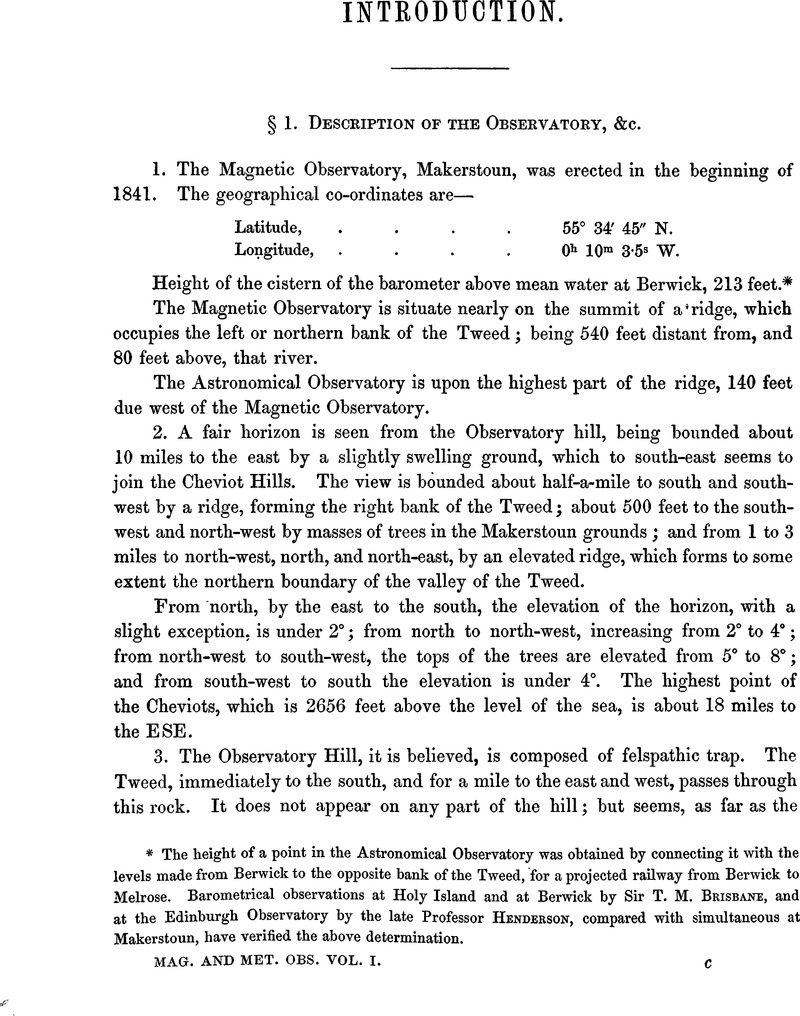No CrossRef data available.
Article contents
Abstract

- Type
- Introduction
- Information
- Copyright
- Copyright © Royal Society of Edinburgh 1845
References
page ix note * The height of a point in the Astronomical Observatory was obtained by connecting it with the levels made from Berwick to the opposite bank of the Tweed, for a projected railway from Berwick to Melrose. Barometrical observations at Holy Island and at Berwick by Sir T. M. Brisbane, and at the Edinburgh Observatory by the late Professor Henderson, compared with simultaneous at Makerstoun, have verified the above determination.
page xi note * Mr Russell studied the methods of observing, &c., at Dublin, under Professor H. Lloyd, to whom he was also indebted for his attention to various difficulties which were subsequently met with. To Professor Lloyd I also owe my acknowledgments for his attention to several of my own communications.
Professor Lloyd, at the desire of Sir Thomas Brisbane, likewise examined the observations made by Mr Russell and by myself till October 1842.
To Mr Airy, Sir Thomas Brisbane's thanks, and my own, are due, for the facilities afforded me at the Royal Observatory, Greenwich, in April 1842, of acquiring a knowledge of the methods adopted there. I should not omit to mention my obligations to Lieut.-Col. Sabine, and Professor Forbes, for their advice on some occasions.
page xv note * It should be remarked that the method of taking away and replacing, recommended in the Report of the Royal Society, does not seem that best fitted for determining the existence of a disturbing cause. During the Observations of 1844, it was found, that, by slightly varying the position of the ring, the effect might be much magnified, or reduced to zero.
page xvi note * A thick cotton cover was put over the whole Declinometer in January 1844, which seems to remedy this very much.
page xxxi note * It was my original intention to enclose the bulb of the thermometer in a metallic capsule (from which this differs little), but it was difficult to determine the thickness of the capsule. Professor Lloyd, to whom I wrote, informed me that he had already adopted the precaution, having obtained a brass bar of the dimensions of the magnet, containing a small iron cup with mercury, in which the bulb of the thermometer was placed.
page xxxviii note * See a paper, entitled “The Balance Magnetometer and its Temperature Correction,” in the Transactions of the Royal Society of Edinburgh, Volume xvi., Part i.
page xlviii note * There is no doubt that these thermometers were placed in a bad position, being open to the effect of radiation from the observatory. This was, to some extent, unavoidable, as there was neither recess nor door on the north wall. Early in 1843, I had the thermometers placed on a revolving case, which could be turned by means of cords and pulleys from within the observatory when required, and left afterwards with a good north exposure.
page l note * Described and figured by Dr Traill in his Physical Geography.
page li note * Early in 1843 I discontinued the use of a stove, and ultimately had it removed.
page lii note * Mr Wallace, of the Edinburgh Observatory.




